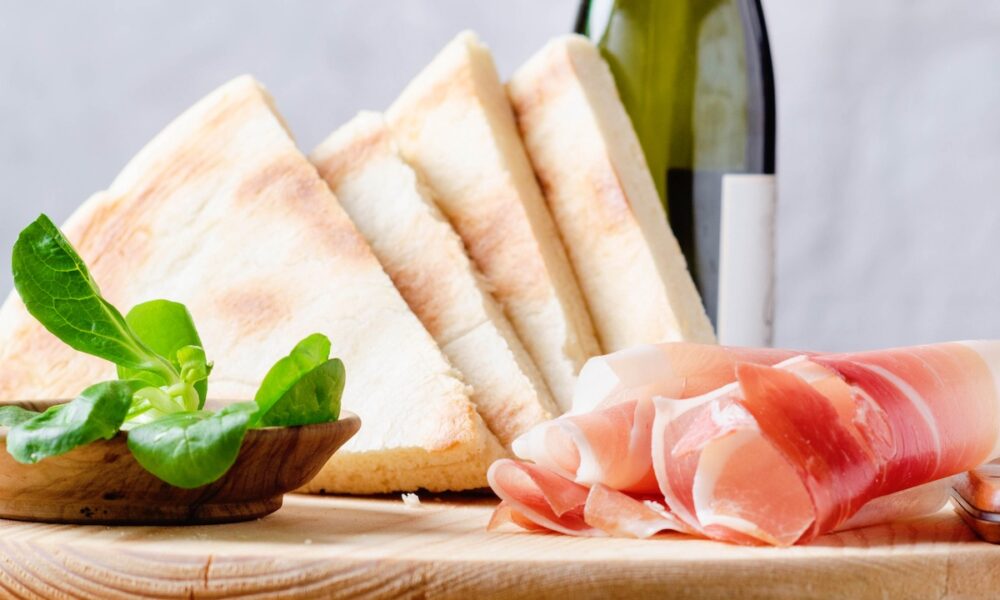Recipes
Umbrian text cake

Torta al testo is a typical recipe from Umbria, a sort of bread cooked in a pan without leavening, perfect for filling.
Italian tradition reserves us many recipes, some less known than others. Specifically, few people know of the existence of the recipe for torte al testo, practically unknown outside the borders of Umbria. Essentially it is unleavened bread cooked in a pan . In fact, the testo is a sort of pan with a very thick bottom widely used in the area.
The recipe is really very simple and requires just a few ingredients: flour, water, salt and bicarbonate (replaced by yeast in the more "modern" versions). However, there is no shortage of reinterpretations of the Umbrian crescia which include the addition of eggs, milk and parmesan to the dough.
How to prepare the text cake with the original recipe
- Place the flour with the salt and bicarbonate of soda in a bowl.
- Mix quickly with a fork then slowly pour in the water .
- When the dough has compacted slightly, finish working it on the pastry board by kneading vigorously by hand. You should obtain a smooth and homogeneous dough .
- Lightly oil the surface, so that a crust does not form, then let it rest for half an hour under an inverted bowl or covered with a cloth. This is to make the dough easier to roll out.
- Then divide the dough into two parts and roll them out with a rolling pin until they reach a thickness of two centimeters . Some versions are thinner, like piadina, but this is also perfect for filling later.
- Heat the text or a non-stick pan and once hot, place the first disc. To check that the surface has reached the right temperature, throw in a little flour: it should darken without burning.
- Prick the surface with the tines of a fork and start cooking. Turn the cake over when a crust has formed on the bottom. In total it will take approximately 15 minutes .
To obtain a perfect testo cake it is very important to adjust the intensity of the flame so that it cooks without burning. If you encounter any difficulty you can also set it to low and cook with the lid on, always taking care that it does not burn.
To obtain a softer dough you can replace part and all of the water with milk . Furthermore, for a tastier bread, it is usual to add one or two teaspoons of grated cheese . Regardless of all the differences, the text cake is never lower than 1 cm.
In this video you can see all the steps and hear a bit of the story (which we have told you below) behind this dish.
Serve it as tradition dictates with sausage and wild herbs sautéed in a pan, adding a few slices of pecorino to taste: you will fall in love with it at first taste! Or go simple with cured meats and cheeses.
Conservation
Testo cake tends to dry out rather quickly so it is recommended to be consumed immediately. However, if you have any leftovers, the best way to restore its original softness is to heat it in the oven at 150°C for 10 minutes wrapped in foil.
Origin and history
The most attentive and passionate about cooking will have noticed similarities between the testo cake and theGreek pita . It is in fact a legacy of the Byzantine era . The cities where the cake is widespread today, albeit with different names, are all located along the so-called Byzantine corridor , a commercial line that connected Ravenna to Rome. It is therefore entirely reasonable to think that among the closest ancestors of the testo cake are the pita and the yufka .
The testo cake owes its name to the testum , a brick tile on which, already in Roman times, focaccias were cooked. Today the text is usually made of cast iron , with a very thick bottom and suitable for being placed directly on the embers.
However, this middle ground between a piadina and a focaccia takes on different names, as mentioned above, depending on the area. In Perugia and in the surroundings of Lake Trasimeno it is called as we have proposed it to you, that is, cake with text ; in the area of Gualdo Tadino, Gubbio and Foligno it is the crescia (creating a bit of confusion with the crescia filo, instead typical of the Marche); in the Tiber Valley and in Città di Castello it is ciaccia and often involves the addition of eggs to the dough; finally in Terni it is often called pizza under the fire .
Speaking of ingredients. Some variations include the addition of different ingredients in addition to the classics. After the discovery of the Americas, some families, to distinguish themselves from the farmers, began to add corn flour to the dough. Today this custom is no longer active.
Riproduzione riservata © - WT